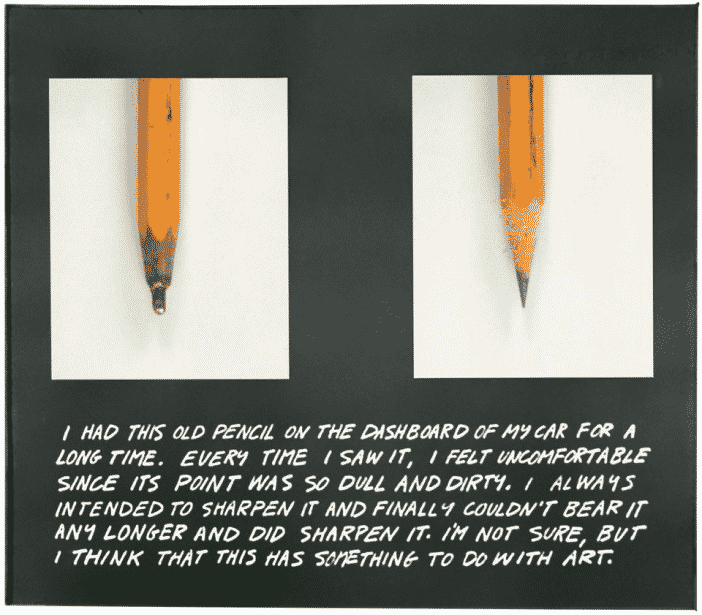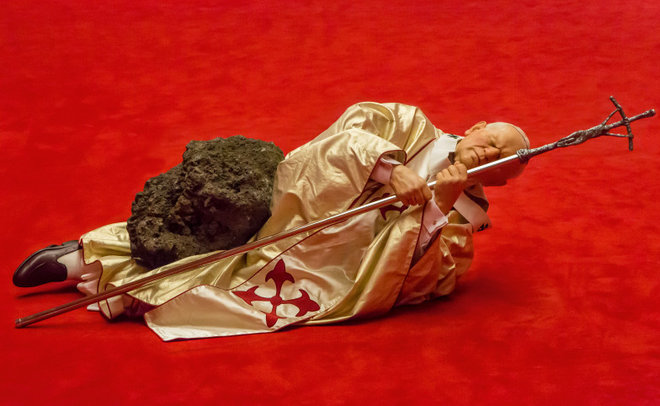In Part 1 of our Conceptual Art Series, we talked about how Marcel Duchamp changed the course of art history with the debut of his notorious 1917 Fountain, and how conceptual art has found a place for itself in the mainstream art world.
But despite the 100 years that have passed since Duchamp took a porcelain urinal, signed R. Mutt 1917 on it, and proclaimed it as art, the art world continues to ask the question, “How do you put a value on conceptual art?”
How do you determine a price on a concept?

Quality Material — Careful Inspection – Good Workmanship. All Combined In An Effort To Give You A Perfect Painting. – “Quality Material” by John Baldessari
Over the years, we would see various works of conceptualism that would come with surprisingly hefty price tags in the art market. In 1970, artist John Baldessari, in an act of disavowal, destroyed all the paintings he had made from 1953 to 1966 so he could move on to creating conceptual artworks he would be most known for. His text-based work Quality Material (1967–68) was once worth a mere $1,200 and hung behind the desk of Michael Findlay who became an assistant at the Richard Feigen Gallery for six months. And in 2007, it sold at Christie’s for $4,408,000.
British artist Tracey Emin’s My Bed gained much media attention when it was first created in 1998. And when it was exhibited at the Tate Gallery in 1999, it would be shortlisted for the Turner Prize. My Bed was an installation work of Emin’s bed with bedsheets stained with bodily secretions. On the floor of the dirty “room” were condoms, a pair of menstrual-stained panties and other everyday objects such as a pair of slippers. My Bed was bought in 1999 by Charles Saatchi of Saatchi & Saatchi and the London-based Saatchi Gallery for £150,000 after displayed at the gallery’s first exhibition. 15 years later in 2014, My Bed was sold at London Christie’s auction for over £2.5 million.

Playfully Pretentious And Artistically Critical
This brings us to a work of conceptualism which would sell in October 2008 for £97,250 from being estimated at £50-70,000 by Sotheby’s. The artwork was “Tin 083,” a tin can weighing 30 grams because it was filled with supposedly human feces. And prior to the 2008 sale, another tin was sold at Sotheby’s for €124,000 at Sotheby’s on May 23, 2007. It too was filled with human excretions.
Italian artist Piero Manzoni’s Artist’s Shit (“Merda d’artista”) artwork consists of 90 tin cans all filled with feces, each with a label in Italian, English, French, and German stating:
Artist’s Shit
Contents 30 gr net
Freshly preserved
Produced and tinned
in May 1961
Ultimately, it’s difficult to say what factors play a role in the pricing of conceptual art. How to assess a value of an idea and who decides what concept is worth more?

Image credit: Marian Goodman Gallery, New York © John Baldessari. | Image source: tate.org.uk
“In conceptual art the idea or concept is the most important aspect of the work. When an artist uses a conceptual form of art, it means that all of the planning and decisions are made beforehand and the execution is a perfunctory affair. The idea becomes a machine that makes the art.” – Sol Lewitt eloquently explained to us, in his Paragraphs on Conceptual Art, published in Artforum in 1967.
In the case of Manzoni’s Artist’s Shit, each can was originally valued according to their equivalent value in gold, making a 30 gram can approximately $37 back in 1961. The price of his art has fluctuated over time, end up selling for hundreds of thousands of dollars, according to the demand of the art market. But one can also note that Manzoni had in full intent and purposes, and assigned a value that the weight of gold, an ancient monetary system we’ve all come to know as standard, was equal to the weight of human excrement.
‘Your work is shit,’ Manzoni was told by his father who owned a canning factory, allegedly. The artist’s idea of excrement, canning of the art, and the weight of gold’s market price came thereafter. In the background, the rapid economic boom in the post-war era and big money culture by the art crowd revealed a deeper dimension to Manzoni’s satire and the point of the legendary “Merda d’Artista.” A barbed provocation for the contemporary art world, undoubtedly aimed at the post-war society, but even more foretelling snag for the current time.
May I Help You?
“If you stuck a piece of shit on the wall, it would be all the same to them as long as someone told them the shit was worth money. That’s the nouveau-riche approach.” in the words of Andrea Fraser, a performance artist. Although the actual context of her statement, marked for a resounding institutional critique, differs from Manzoni’s. Yet the substitution of art and shit in its forthright resonance in cultural critique seems to meet in the same point.
The sentence “If you stuck a piece of shit on the wall..” was part of Andrea Fraser’s script for her performance work (1991), “May I Help You?”
Oh yes please, we say!
After all, “Art,” whether conceptual version or not, never fails to lead us to more questions than answers.



![[Left] Kusama with her piece Dots Obsession, 2012, via AWARE, [Right] Yayoi Kusama (Courtesy Whitney Museum of American Art) | Source: thecollector.com](https://www.artdex.com/wp-content/uploads/2024/04/Left-Kusama-with-her-piece-Dots-Obsession-2012-via-AWARE-Right-Yayoi-Kusama-Courtesy-Whitney-Museum-of-American-Art-Source-thecollector.com--300x172.png)



